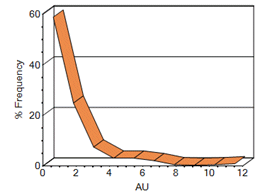|
|
Histograms - Data Selection |
To access this dialog:
-
Open the Histogram dialog - the Data Selection tab is shown by default.
The Data Selection tab is used to define the histogram data source, chart types, layout and histogram parameters.
Field Details:
Files and Fields: this group contains the data source controls:
-
Loaded Data: select this option and an item from the drop-down list to use an object currently loaded in memory.
-
Data File: select this option and use the browse button on the right to select a Datamine (.dm) file on your local or network system.
-
 : browse and select a data file (*.dm) that has been added to the project. Opens the Project Browser dialog.
: browse and select a data file (*.dm) that has been added to the project. Opens the Project Browser dialog. -
 : refresh/reload the data file.
: refresh/reload the data file. -
Value Fields: Value fields include the complete set of numeric fields in the selected data set (object or file). It is possible to select up to 10 value fields to be displayed in histogram charts. At least one value field must be selected before a histogram can be displayed. Any value selected in the Weight Fields column will not be available for selection.
-
Key Fields: all fields, both alphanumeric and numeric, in the selected data set are listed in the Key Fields column. This is an optional field; up to 5 fields may be selected. The selection of a key field causes a separate histogram to be created for each different value within that field; these will generally be alphanumeric or integer fields (e.g. rock type or mineralization zone codes).

In addition to the charts generated for each Key Field(s) value, the first chart in the series is a non Key Field chart containing all data.
-
Weight Fields: as for the Value Fields, this is a list of all the numeric fields in the data set, but any field selected in the Value Fields column will not be shown here. Weight field selection is optional. Value Fields selections are weighted by the selection before being represented in the chart. Up to 3 weight fields may be chosen. If multiple Weight fields are specified, then the combined weight is calculated by multiplying the individual weight values together.
|
|
Multiple value, key or weight fields can be selected or deselected using <Ctrl> + click. |
Chart Types: the following basic chart types are available:
-
Incremental Histogram: a graphical display of tabulated frequencies, shown as bars. It illustrates the proportion of cases which fall into a series of designated categories or bins:

-
Cumulative Histogram: a graphical representation that accumulates all the samples in all of the bins up to the specified bin. As above, these are represented as bars or lines:

-
Probability Plot: a graphical representation used for assessing whether the selected dataset follows a normal or lognormal distribution. The straightness of the line indicates how close the distribution is to a normal or lognormal distribution:
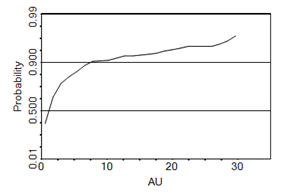
For each of the graphics shown above, custom formatting options have been used - note that a wide variety of formatting options are available for all chart types.
-
Normal/Log: for each of the chart types, Normal and/or Lognormal scaled chart variations (i.e. for the Value axis) can be generated. A Log ('lognormal') distribution is a single-tailed probability distribution whose logarithm has a normal distribution. The graphic below shows a log probability plot, incremental histogram and an incremental log histogram:
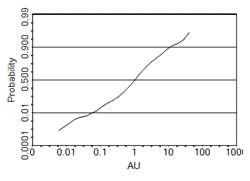
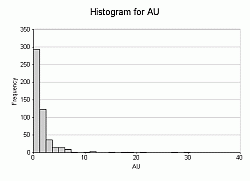
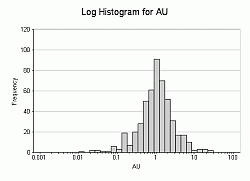
|
|
How are Values Treated for Log Chart Types? For the purposes of chart generation, all values (i.e. those for the selected Value Fields), which are <= 0 (zero) or absent (-), are ignored. This means that the number of effective samples is reduced. Logarithmic values are calculated to base 'e'. |
-
Bin/Line: for Incremental and Cumulative histograms, you can choose between a line or a bar graph. If you wish to use a bar graph, select the Bin option. For line graphs, select Line. The graphic below shows the same Incremental histogram using both Bin and Line options.

|
|
A 'line' histogram can also be displayed in 3D - ensure the 3D mode icon is enabled and right-click-and-drag the preview area to show a non-orthogonal view, e.g.:
|
-
Frequency/% Frequency: by default, for Incremental and Cumulative histograms the Y axis annotation will show the number (frequency) of values falling within a bin. An alternative option is to show the percentage frequency i.e. the number of values in a bin expressed as a percentage of the total number of values.
Histogram Parameters: the following sample control options are available:
-
Ignore Samples Out of Range: select this option to exclude data that are less than the minimum or greater than the maximum values (as specified on the Format tab). Chart generation will be performed as if those data values were missing from the data set.
-
Place in bottom/top histogram bin: select this option to place data in the lowest or highest bin if the data are respectively either less than the minimum or greater than the maximum (as specified on the Format tab).
-
Minimum No. of Samples: define a value for the minimum number of required samples for histogram generation; below this, the chart will not be calculated and displayed; as a general statistical rule of thumb, this value can range from 45 - 120.
Chart Layout: there are two options for chart layout:
-
Individual Charts: select this option to generate an individual histogram for each individual data set defined by the selection(s) made in the ValueFields and KeyFields columns. Each chart will be listed independently on the Charts tab and will be displayed individually. You can also edit the histogram chart's properties to facilitate display of these multiple charts in a tabular arrangement. More...
-
Compound Chart: select this option to generate a chart that contains more than one individual chart. Compound charts will be constructed from the same chart-generation rules as their individual chart equivalents, but only one chart will be created.
A common use for a compound chart would be to compare the histograms of a single Value field for different Key values. For example to compare the histograms of Au for different rock types.
|
|
When displaying compound charts, try setting the chart type to Line (see above) to prevent bars being hidden behind others in a 2D view. Alternatively, try viewing compound charts with the 3D view enabled. |
-
Delete Empty Charts: tick this box to delete any histogram charts that have less than the minimum number of samples, as specified above (default 'ticked').
Summary: this read-only section of the panel shows a summary of the main parameters used to create the Histogram chart:
-
No. of values: this denotes the number of Value Fields that have been selected (one or more).
-
No. of values for key field n: the number of unique values of each Key Field is shown.
-
No. of chart types: this row indicates how many different chart types have been specified.
-
Maximum number of charts: this value denotes the number of individual charts that will be created.
|
|
When a project file is opened which contains charts that make used of linked files (and not loaded data) and the linked file(s) cannot be located (perhaps because it is unavailable, has been renamed or moved), the following error message is displayed:
Clicking OK will then display the Open dialog which is used to browse and select the required file(s). |

Using the Data Selection Tab
-
After opening the Histogram dialog for either a new or existing histogram chart, select the Data Selection tab.
-
In the Files and Fields group choose whether to base the histogram on Loaded Data (that is, data in memory) or values held in a physical Data File.
-
For Loaded Data: use the drop-down list to select from the objects currently loaded into memory.
-
For a Data File, use the browse button to select the desired file on the local system or network.
-
-
Select one or more (press the <CTRL> key) Value Fields from the list. Note that you can also select multiple concurrent value fields using the <SHIFT> key.
-
Key fields are optional. Select one or more if you want multiple charts displaying the data divided into the selected key categories.
-
Weight Values are also optional. A weight field, if selected, is applied to the Value fields – it is a simple multiplier.
-
Selecting Apply or OK will update the preview area and the plot item/sheet within the Plots window.
| |
Related Topics |
|
|
Histograms |

